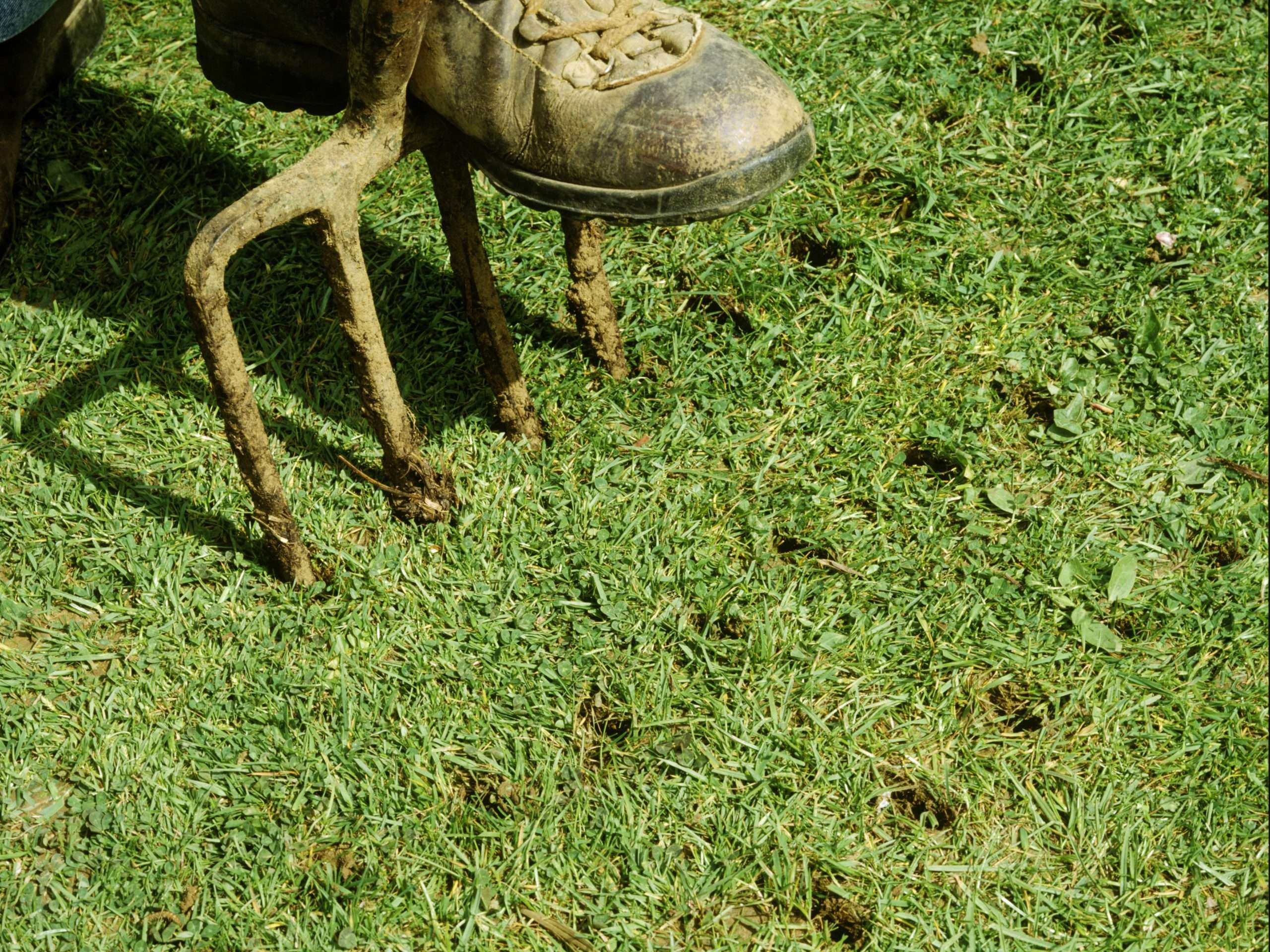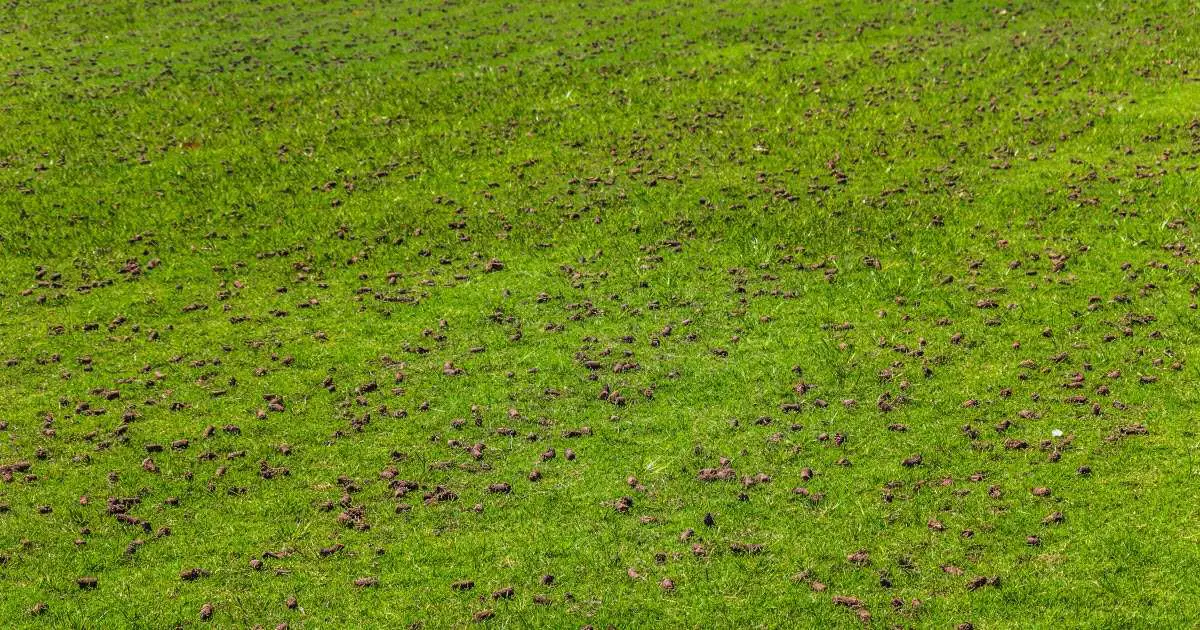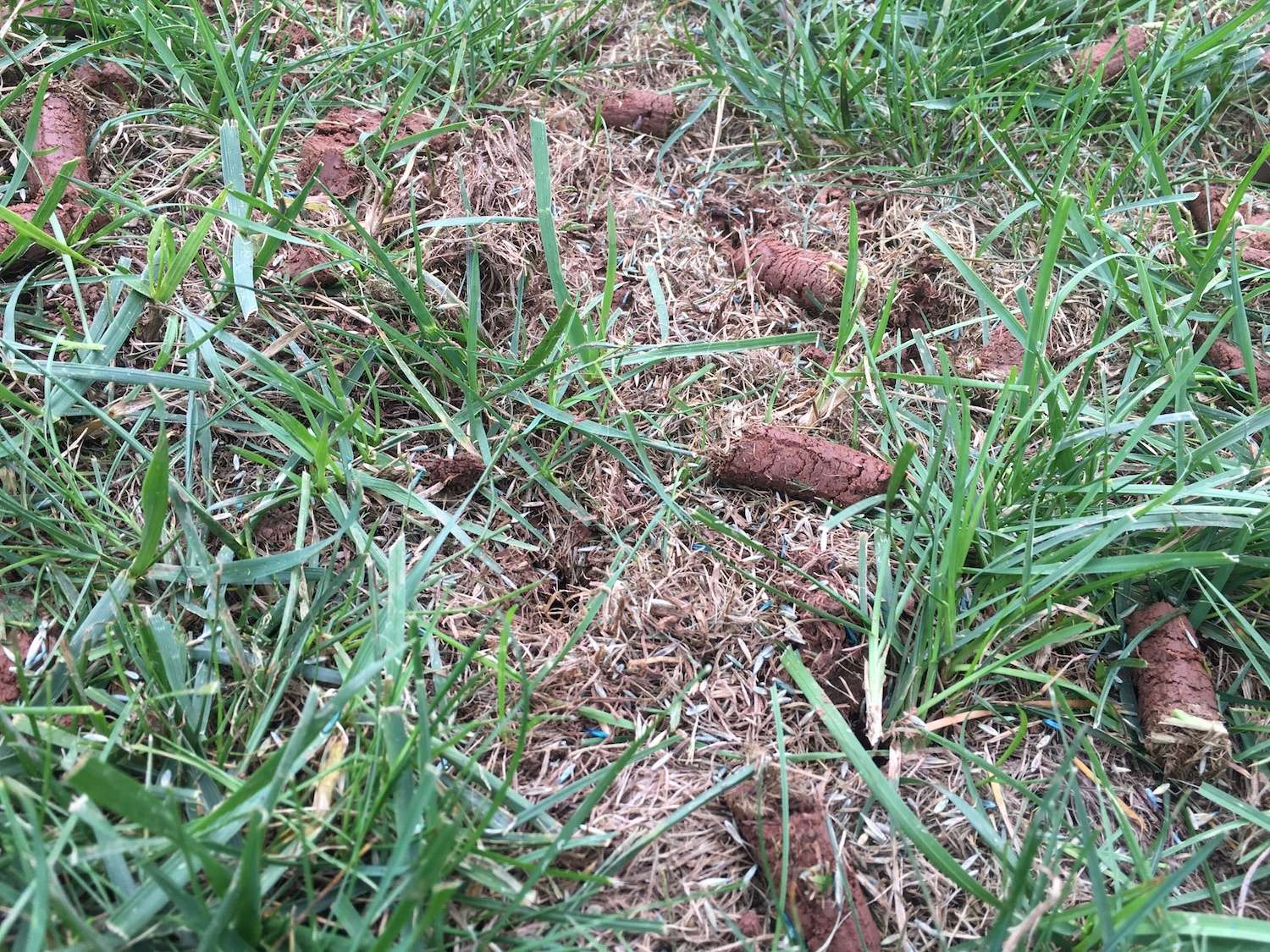What To Do Before Aerating Your Lawn
- Mow your lawn before watering and aerating it.
- Be sure to water your lawn thoroughly two days before aeration. The tines on the aeration machine penetrate loose soil better than dry soil. If the soil is too dry, the tines will have trouble effectively piercing the ground.
- Avoid aerating immediately after an extended period of rainfall. Soil thats too wet will stick to the inside of the tines instead of falling easily back into the lawn.
- Plan to pass over your lawn in two or more directions. This ensures a more even, thorough coverage. Most sources agree that you should aim for 20 to 40 holes per square foot.
The Best Time To Overseed Grass
Overseeding means planting new grass to fill in any bare orworn patches. This is helpful for having a gorgeous lawn that looks thick andhealthy all year long. The best time to overseed depends on two factors: whereyou live and what kind of grass you prefer.
Many homeowners in northern states choose cool-seasongrasses, and southern areas often select warm-season grasses. Each type ofgrass has distinctive growth patterns and needs, so make sure to speak with ourlawn professionals if youre not sure what variety to choose. Here are theoptimal overseeding times for several locations and grass types:
- PacificNorthwest : Plant new grasses about six weeks beforethe first projected snowfall. These are generally cool-season grasses.
- SouthwestU.S. : Early spring is the best time foroverseeding in these areas.
- Southernstates : April, May and June are good times tooverseed in this huge area. The best time may vary each year depending on soiltemperatures. You want warm-season grass to have a cozy environment togerminate in.
- Northeaststates : Due to the cold temperatures prevalent in theseareas, its best to start planting grass seeds in August or September to givethem some time to grow before winter hits.
- MidwestU.S. : Weather conditions vary quite abit depending on how far north you live, but a safe bet is to overseed lawns bythe end of August or early September at the latest.
Read Also: Kill Wild Violets In Lawn
What Equipment Do You Need For Aeration
There are different kinds of equipment that can be used for aeration.
Core or plug aerators are generally believed to be the best . A core or plug aerator will have hollow tines, arranged in rows. These will remove plugs of soil from your lawn and then put them back on top of the grass.
Some people wonder if they should mulch mow these core aeration plugs to help them break down quickly. I dont recommend that. Given time, these plugs will break down and add nutrients to the soil on their own schedule.
If you mow and chop those plugs up with your mower, that soil will drop right back into your aeration holes and fill them in. Thats not really what you want.
Recommended Reading: Coyote Statue To Scare Geese
When You Should Aerate Your Lawn This Spring
The best time to aerate your lawn is when it is actively growing. It sounds pretty straightforward, right? But what complicates things a little is that the active growth period is different for different kinds of grasses. For cool-season grasses, the best time to aerate is both in spring and in fall. For warm-season grasses, however, the right time is spring through summer. To know when you should aerate your own lawn this spring, its important to know what type of grass you have and when each type should be aerated.
Different Varieties Of Soil

Different types of soil also determine the ideal time and frequency of lawn aeration. Because clay soil compacts so easily, it should be aerated once a year or more. Since most people in Ann Arbor MI have clay soil, aeration is especially important there.
Homeowners who have sandier soil can aerate their lawns once a year, or even every other year. In drier climates, aerating your lawn twice a year will help your lawn grow faster and stay healthy.
Also Check: Rent To Own Riding Mower
Lawn Care: Never Aerate Cool Season Lawns In Spring
Mike McGrath, wtop.com
Most local lawns should be aerated only in the fall
Carole in Columbia, Md. writes: I bought a Groupon for lawn aeration and over- seeding last summer, but when I tried to make an appointment the company said they were way overbooked . Now they tell me that theyre making appointments for the first week in March. Is that really a good time to aerate and seed my cool-season lawn? Or should I ask them to honor the Groupon in the fall?
Cool season lawns like bluegrass and fescue should never be aerated in the spring or summer, Carole. Although it does relieve soil compaction, aeration stresses the turf a bit, and lawn owners should avoid any extra stress as our lawns get ready for the summer swelter. Thats why aeration should only be performed in the fall. Cool-season lawns are at their strongest going into the cooler weather, and arent stressed by aeration then.
Note: The opposite is true for warm-season grasses like zoysia and Bermuda. They should be aerated in the spring right after they green up fully for the season.
And, sowing grass seed in the spring is useless with cool-season lawns. Aug. 15 through the end of September is the only rational time for bluegrass, rye or fescue seed to be applied.
So either get a delay until the fall or ask for a refund.
Timing corn gluten and grass seed
Scott in Springfield writes: Whats the best way to time the use of grass seed and corn gluten in my lawn so I can maximize the benefits of both?
Practical Lawn Care For Western Oregon
Alec Kowalewski |Aug 2014 |OSU Extension CatalogPeer reviewed
This publication describes the benefits of choosing the right cultivar, species, blend, or mixture. It will also explore the advantages of seed coating and other preplant packaging options, such as fertilizer and mulch. Finally, …
Alec Kowalewski, Brian McDonald |Nov 2014 |OSU Extension CatalogPeer reviewed
The mild, wet winters in western Oregon encourage the growth of lawn mosses. This publication describes the factors that contribute to this growth and provides tips for reducing problems. It is a companion to OSU Extension video EM 9176.
Brooke Edmunds, Alec Kowalewski |Dec 2017 |OSU Extension CatalogPeer reviewed
Alec Kowalewski |Jun 2017 |OSU Extension CatalogPeer reviewed
Rory McDonnell studies environmentally friendly slug control methods–such as essential oils from plants
Gail Wells |Apr 11, 2016 |News story
Learn to identify common pests and beneficial insects found in grass seed production fields across Oregon. This handy pocket guide covers: Where pests are found. Symptoms of pest damage. Pest lookalikes. …
Joe DeFrancesco, Silvia I. Rondon, Nicole Anderson |May 2021 |OSU Extension CatalogPeer reviewed
You May Like: Fake Coyote To Scare Geese
You Aerate And Overseed During Dry Conditions
Aerating is easy on your turf, and you, when your soil is slightly moist. Overly dry and compact soil is harder to penetrate and requires more manual effort to push the machinery. Especially during times of drought when you grass is already stressed, its best to wait until the day after a good rainfall before aerating.
When To Core Aerate Warm Season Grasses
For warm-season grasses, the best time to core aerate is in the early summer because the roots for these plants are most active during this time of year. Aerating warm season grasses in the fall will not provide the benefits of improving root growth since the turf is beginning to enter a dormant period and growth will stop.
Also Check: Lease To Own Lawn Mowers Near Me
Aeration & Overseeding Mistakes To Avoid
When done correctly, aeration and overseeding can greatly benefit your lawn.
Avoid common mistakes which will cost valuable time and money, along with not gaining maximum benefit from work done.
Avoid these typical errors people tend to make when aerating and overseeding:
Recommended Reading: Is November Too Late To Plant Grass Seed
You Aerate And Overseed During The Wrong Time Of The Year
The proper time to aerate is when new life has the greatest chance to grow in your region. You wouldnt want to aerate and overseed too early, before the last frost hits for example, and kill the seeds. You also wouldnt want to do it during the peak of a hot summer, when the harsh sun and temperature suppress new growth.
For cool-season grasses, common in northern lawns, aerate early fall or spring. Warm-season grasses, common to southern lawns, grow best in the late spring or very early summer. Not sure which applies to you? Here in Pennsylvania, cool air and moist soil in the fall and spring make it the perfect time to lay fresh turf, helping to build greater resistance against disease, insects, and drought.
Don’t Miss: How Much Does Trugreen Cost Per Month
Why Should You Aerate Your Lawn
Aeration is one of the most important lawn maintenance treatments of the year. Experienced lawn maintenance professionals and gardeners will study the soil to gauge the compaction and determine if it needs aeration. Here are some reasons why you might need lawn aeration in Toronto:
When is the Best Time to Aerate Your Lawn?
If you hire lawn maintenance services, you do not need to concern yourself with the lawn care schedule. Experts usually customize their aeration schedule according to the soil conditions, weather, and the type of grass. The best time to aerate the lawn is just before the growing season. This allows the grass to heal and develop stronger roots. The grass roots will spread to areas where you have removed the soil plugs and gain a fresh supply of air.
Why Choose Greenbloom for your Lawn Maintenance in Toronto?
When Not To Aerate Your Lawn

Knowing when to aerate your lawn is important, but it is equally important to know when you should avoid aeration. Aerating a lawn during times when the grass is dormant is never a good idea because it can open your lawn up to weed growth or other problems. You should also avoid aerating when your lawn is wet or when it has enough moisture on it to be muddy. While it may be tempting to aerate before the warm weather arrives, it really is best to wait until the grass is actively growing before scheduling your aeration service.
Recommended Reading: Corn Speedwell Herbicide
You Dont Choose The Right Equipment
Weve all seen the do-it-yourselfers walking across their lawn in cleats, poking holes in the soil. Instead of investing in an aeration machine, they think aerating is just about creating holes but actually, the concentrated force of stepping with a spiked shoe further compacts your soil. Even spike aerators, which use a solid tine or fork to poke holes, can cause additional compaction in the areas around the holes.
For best results, use a plug aerator, which removes a core, or plug, of grass and soil from your lawn. Look for an aerating tool or machine that removes soil plugs approximately two to three inches deep and roughly half to three quarters of an inch in diameter, about two to three inches apart.
Aeration: Why How & When To Aerate Your Lawn
In order to achieve and maintain a beautiful lawn, you should employ basic lawn care practices such as properly mowing, fertilizing and watering. It is also important to ensure that nutrients can reach the soil beneath your grass. Aeration can be an extremely vital element to a healthy lawn because it allows air and water to penetrate built-up grass or lawn thatch.
Get rid of thatch and make way for a beautiful lawn with this quick guide to aeration. Youll learn why, how and when to aerate your lawn for the best results.
Also Check: John Deere Smallest Riding Mower
How Frequently Should You Aerate Your Lawn
For most residential lawns, its best to aerate about once a year. As long as you are aerating at about the same time each year, an annual aeration should be all you need to support healthy lawn growth throughout the growing season. At the same time, if your lawn gets a lot of foot traffic or the grass just doesnt seem to thrive throughout the year, you may need to aerate twice a year until healthy growth is restored.
How To Aerate Your Lawn
Aerating equipment comes in three main types, from small manual versions to larger tractor-like or pull-behind machinery:
- Spike aerators simply poke a hole down into the soil with a solid, spike-like tine. Some homeowners wear spiked aerator sandals” strapped to their shoes to aerate as they do yard work. While these can help on a small scale, spike machines can make compaction worse by pressing soil together around the holes.1
- Slicing aerators have rotating blades that cut or slice through grass and thatch and down into soil. Like spike aerators, slicing aerators leave soil in the ground, but they create pathways for air, water and nutrients without causing more compaction.
- Core or plug aerators, typically preferred by lawn professionals, use rows of hollow tines that remove plugs of soil from your lawn and deposit them on top, where they break down. The size of the plugs and the holes they create vary in width and depth, depending on the machine used.
You can hire a lawn service to aerate for you or do it yourself like a pro. Equipment rental companies and lawn and garden stores often rent aerator machines and provide basic operating instructions for the model you choose. Aerating is a lot like mowing as you work back and forth across your lawn. Concentrate on any known problem areas, like pet runs or backyard baseball diamonds. Make several passes in different directions to help ensure optimal coverage and benefits.
Read Also: How To Get Rid Of A Riding Lawn Mower
When Is The Best Time To Aerate And Overseed In Vancouver
Aerating and planting grass is a great way to keep your lawn lush, healthy and green, but done at the wrong time of the season, they can also be a big waste of time and money. You can count on the lawn care experts at Nutri-Lawn Vancouver to know the optimal time of the season for all your lawn maintenance jobs so you dont waste energy and resources.
When Should You Aerate Your Lawn
Maintaining a healthy lawn takes work and proper timing. Doing the right thing but at the wrong time can delay growth or even cause damage. The adage too much of a good thing definitely holds true. There are a few tried and true maintenance tasks that can give your lawn a needed spring boost for fantastic summer growth. You can trust the experts at Nutri-Lawn Ottawa for professional advice.
Aeration is an important spring maintenance task. Aeration is the removal of plugs of soil in your lawn. This is done for a few reasons to reduce soil compaction, improve water absorption, deal with thatch, and encourage deeper root growth. Homeowners typically want to combine aeration with fertilizer and overseeding.
Also Check: Aerify Plus Home Depot
Why Aerating Helps Lawns
Grass roots need air, water and nutrients to grow thick, deep and strong. When soil becomes compacted, even slightly, it inhibit the flow of the essentials that support thicker, healthier turf growth. A layer of compacted soil just 1/4 to 1/2 inches thick can make a significant difference in the health and beauty of your lawn.1 Aeration creates holes down into the soil to alleviate compaction so air, water and nutrients can reach grass roots.
Deprived of their basic needs by compacted soil, lawn grasses struggle in stressful situations, such as heat and low rainfall, and lose their healthy, rich color. Grasses gradually thin and eventually die out completely, for lack of the oxygen, water and nutrients available just inches away. Even a single aeration session can open the avenue for these essentials to reach their mark and put your lawn back on an upward trend.
Core aerators pull small plugs of soil to the surface.
Can You Aerate In July

Aerating in the summer is fine, as long as the ground is soft enough to pull plugs. There really isnt a good reason not to, but then again there isnt a good reason not to wait till fall. Its just more advantagous to do it when youll be fertilizing and overseeding.
Can I aerate lawn in June?
So yes, you can aerate the lawn in the summer just keep reading. Warm weather grasses include Zoysia, Carpetgrass, Bermuda, Buffalo, Centipede Grass, Bahiagrass, and St. Augustine. You should aerate warm weather grass when the weather gets warm through the late spring and early summer.
You May Like: Starter Rope Lowes
